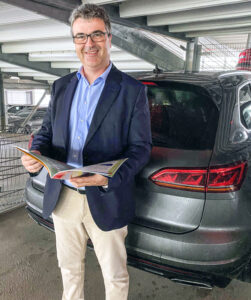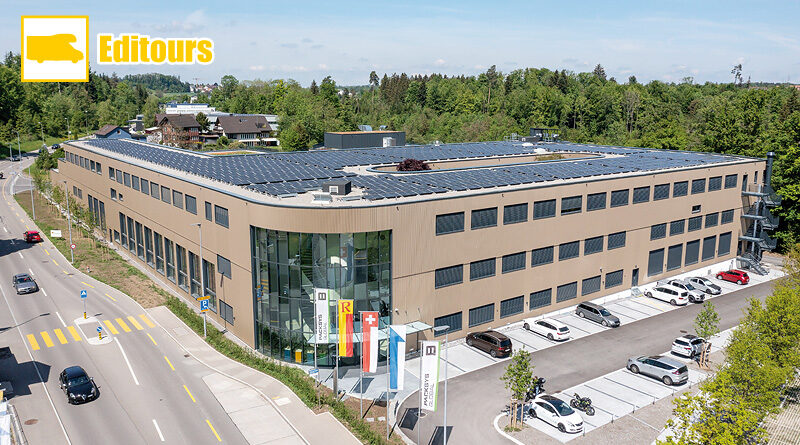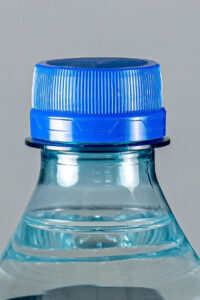Where caps go under the knife
Tethered caps require complex cutting geometries
As part of the Brückner Group’s Pre-K press conference in Freilassing, Bavaria, we met Beat Rupp, CEO of Packsys Global. Their machines are essential when it comes to implementing the EU Directive on tethered caps.

Along with complete systems for extruded tubes and laminate tubes, automatic hot embossing solutions and packaging solutions for a wide range of containers, rotary slitting and folding machines for plastic caps are designed in Rüti, near Zurich in Switzerland. The latter have become a particular focus of attention because of the tethered caps directive; from July 2024, a total of 255 billion closures p.a. in the EU must be designed in such a way that they stay attached to single-use containers even under a breakaway force of 25 Newtons. This requires complex cutting geometries that are not only horizontal but also vertical and diagonal and extremely precise.
This is the specialist field of Packsys Global AG. Great effort has gone into this issue over the last three years, and customers can now be offered the SmarTether, ExperTether and CapCompass solutions (see information below). These are distinctive in that they can be used on all common neck styles, including GME 30.40 (26 mm). “All requirements can be met purely through adjustments in the slitting,” explains Beat Rupp. “For our customers, this means that existing systems can be retrofitted.” The precise alignment of the cutter is more relevant than ever. “Previously, caps were cut above a take-off ring; today different elements and levels are needed to produce the various tethered cap variants,” says Rupp.
At present, it’s impossible to predict which cap variants will catch on. “Ultimately, it will be the solutions that are the simplest to replicate and that are easily understood by consumers,” Rupp assumes.
While all compression moulded caps have to be cut, injection moulded caps can either be cut or the band supports can be integrated into the moulding process. Slitted designs have the advantage that the process creates only minimal gaps. The cap application process is more stable due to the better mechanical alignment. In addition, slitting has the advantage of offering a better visibility after first opening due to a wider drop zone, a clear advantage for the end consumer. “Eventually, every variation will be on the market, including hybrid solutions combining both technologies” says Rupp. He’s delighted about a new customer group that Packsys could win over: “Tethered caps are an issue not only for PET bottles but also for drinks cartons. Gable-top cartons need an oriented cut to ensure that pouring isn’t hampered by the cap. Here, our CapCompass can be combined with TE-band cutting,” explains Beat Rupp.
After two challenging years of pandemic, the company is on the verge of an upturn in the drinks machinery field thanks to the high demand for tethered cap solutions.
It all started with the laminate tube
Tethered caps weren’t on anyone’s mind when Packsys was founded in 1969 by Karl Mägerle. Under the name KMK Maschinen AG, the company produced systems for laminate and extruded tubes. To stay abreast of various takeovers and the growing product portfolio in the field of packaging machinery – including the cap cutting machinery field in the early 2000s, – the company was renamed Packsys Global in 2004. Further mergers, for example with Combitool AG in 2020 and Texa AG and Madag Printing Systems in 2021, have enabled further portfolio growth.
These mergers have also been reflected in a new company headquarters. To bring all the companies under one roof, a new 15,000 m2 building has been constructed just 500 m from the previous headquarters in Rüti, Switzerland, with residence taken up in October 2021. Beat Rupp explains the thought process behind the mergers: “Packsys is a classic line and solution provider. Previously, a customer had to contact different companies at different sites with different contact partners; now it’s all much simpler. Behind the scenes, we bundle our technologies under one roof, but the customer only needs to speak to one contact to find a complete solution.”
In Switzerland, Packsys has 230 employees; with its employees in India, China, USA and Japan, the number rises to over 300.
“Short-term thinking is no good in engineering”
In 2011, the Swiss company Packsys Global was taken over by the Brückner Group, which also owns Brückner Maschinenbau, Brückner Servtec and Kiefel Technologies. Beat Rupp considers the position in a holding company an advantage for Packsys: “The focus of the holding is on strategic issues such as sustainability and digitalisation, from which we at Packsys can benefit. At the same time, we maintain a great deal of independence to manage Packsys in line with our vision for it.”
Beat Rupp has left the company some years ago, but his professional path has brought him back to Packsys, most recently in 2019 as CEO. The management and owners of the Brückner Group have played their part in this too. “Short-term thinking is no good in an engineering and technology environment, and sometimes some stamina is needed,” says Rupp. “The owners, the Brückner family, decide quickly and think long-term. This gives us planning security.” In 2021, the baton was passed from company founder Gernot Brückner, now 85, to his son Moritz, who is continuing the family business in the same spirit.
Taking responsibility
At the end of our conversation, Beat Rupp tells us about a project close to his heart. ‘Buy Food with Plastic’ is a charity initiative addressing the problems of hunger and plastic pollution in rural parts of developing countries, where collected PET bottles can be used as currency to pay for meals. Packsys supports them financially and organisationally. Detailed information on Buy Food with Plastic can be found in PETplanet 7+8/2022.
SmarTether
A choice and combination of multiple horizontal, together with several vertical knives, allows slitting with either a randomly positioned hinge or a lasso styled tether. SmarTether was designed mainly for the changeover from standard to tethered applications. Single cut as well as tethered multi cut with diagonal and vertical cuts can be combined with the same tooling.
ExperTether
ExperTether is designed for multiple slitting lines on both the horizontal and vertical axes. The spindles are fully and accurately synchronised to the slitting knives, located at the outside of the rotating slitting turret. The slit line pattern on mandrel matches to the knife pattern. A continuous and accurate slitting process support is ensured, identical as known from standard TE band slitting.
CapCompass technology
Simultaneous spindle movements allow accurate positioning of the plastic closure before slitting process starts. Optimised machine kinematics, paired with sequential knife penetration, provide gentle closure handling and make it therefore suitable for gable top package closures or thin wall and light weight closures. After opening, the closure will flip away to a non-disturbing position. CapCompass orientation technology can be used with both SmarTether and ExperTether to achieve the customer’s desired tethering style.



